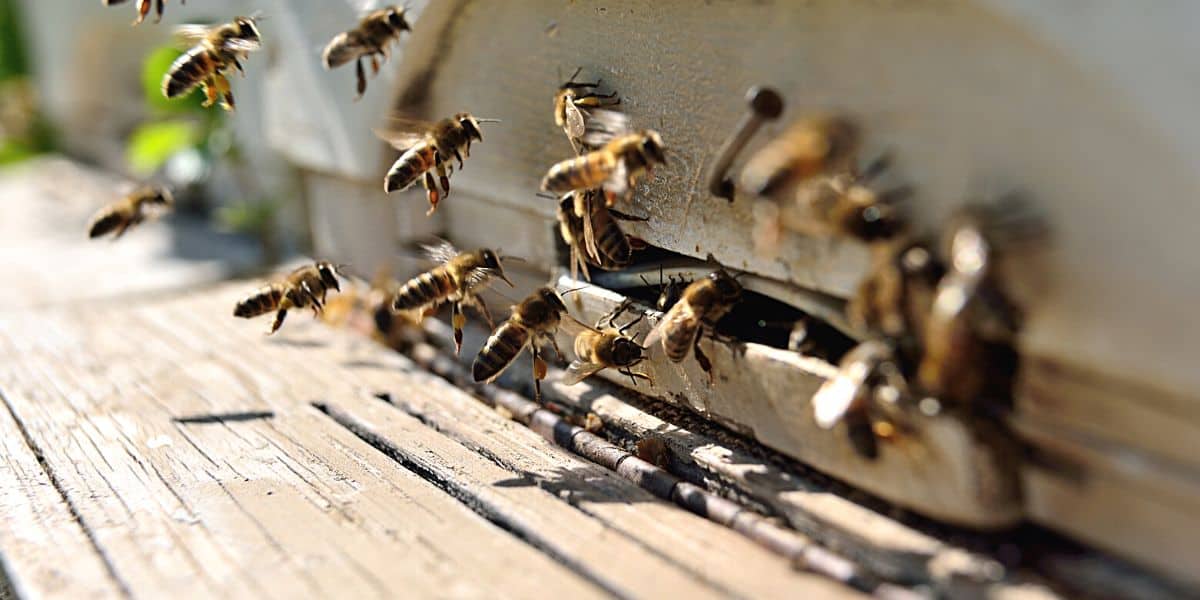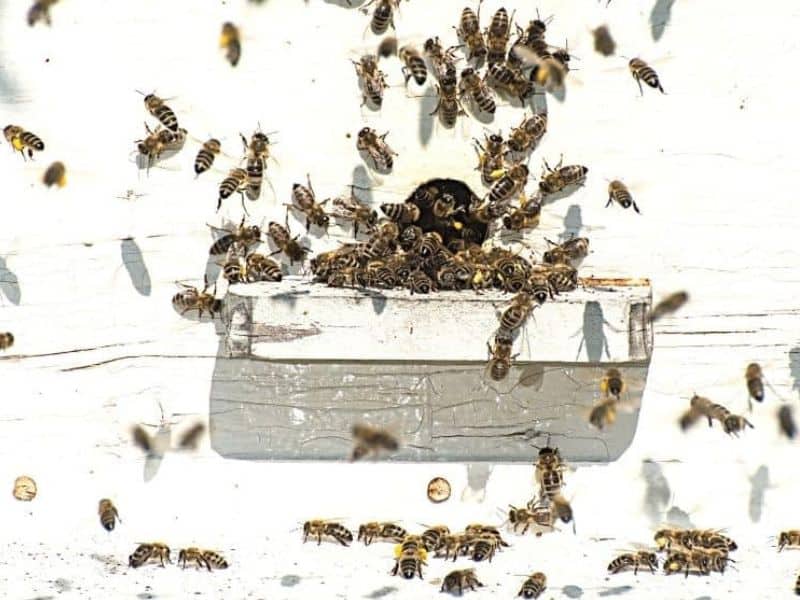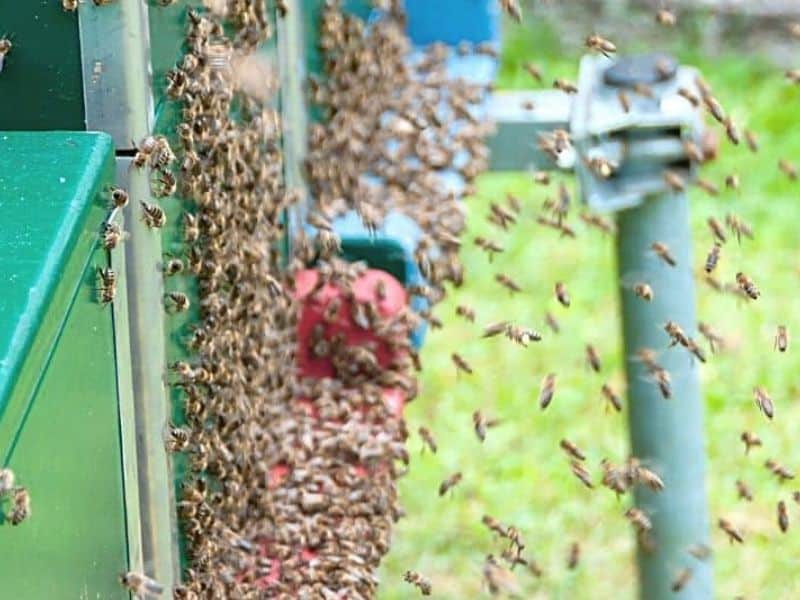Bee Orientation Flights
The first time a beekeeper notices bee orientation flights can be scary. Not much strikes more fear in the heart of a new beekeeper than seeing a mass of bees flying around the entrance to the hive. Due to a lack of experience, the first thought is that your bees are about to leave. Thankfully, that is not usually the case and with some research and experience you will learn to just relax and watch.

Orientation flights of honey bees is one of the most intriguing bee behaviors. After many years of beekeeping, I still stop to watch. It is just another interesting honey bee fact of life and they do everything for a reason.
Recognizing a Honey Bee Orientation Flight
Worker bees leave the hive every day – these bees collect resources needed by the colony. They form a steady stream of traffic leaving and returning to the hive.
However, those leaving the hive for the first few times only fly a short distance away. Then, they return to the hive entrance and sway out and back in a zig zag pattern.
Orientation flights only last for a few minutes – though you may see hundreds of bees doing this exercise at one time.
They are familiarizing themselves with the immediate surroundings of the hive. Over the next few minutes, the bee flies in larger circles around the hive before returning and going inside.
The average age of new bees performing orientation flights is about 14 days after emergence from their cell. Younger bees tend to stay closer to the hive while those nearer foraging age fly farther away.

Landmarks
This flight exercise helps the bees memorize the hive location and any nearby landmarks to enable them to return home.
Navigation from and back to the hive is done using the angle of the sun, magnetic fields of the earth and local landmarks too.
Landscape features such as an open field, grassland, a hill or a line of trees can all be used by bees to keep themselves on the right course.
Long range orientation flights take place as the bee ages and prepares for work outside. This is important because honey bees can travel quite far to collect food.
Re-Orientation After a Move
Of course, a group of young adult bees is not the only time a beekeeper sees orientation flights. Bees will also perform re-orientation flights if the beehive has been moved to a new location.
The makes perfect sense. The hive has moved – the bees must reset their (GPS- or is that BPS) before going out to work.
Because bees do respond to landmarks, having items in your beeyard (post, tree, bush) may aid in helping bees find their way back to the proper hive. This is also a reason to decorate your beehive with symbols or designs.
All Honey Bees Do It
Every kind of bee in the hive performs some type of orientation flight patterns. The queen honey bee will take a couple of short orientation flights before she flies away on her mating flight.
After mating at the drone congregation area, she will never leave the hive again unless with a swarm.
Some of the older workers that travel with her for the mating flights may be seen doing orientation flights at the hive entrance in the days prior.
Even the males, drone bees take short navigation flights in the days preceding mating flights. They too must learn how to navigate and recognize the hive and any landmarks.

Timing of Bee Orientation Flights
Honey bees most often perform these orientation flights on warm, sunny afternoons. One of the most intriguing aspects for me as a beekeeper – is that all of the hives in the apiary tend to do this behavior at the same time. This can be quite loud if you have several hives.
Why does this happen? Is it because the weather is perfect in some way? Do the bees hear the neighbors outside and want to go out and play too? We simply do not know for sure.
However, recent studies using harmonic radar are delving farther into the mysteries of bee orientation behavior.
If the weather has been rainy for several days, it is common to see bees outside orienting early in the morning – once the sun is out. Weather conditions affect many aspects of hive life.
This activity may give some hints about hive status too. If several hives have hundreds of orienting bees and one hive has a handful – why is this happening.
Is this hive weaker in population? Perhaps there is no problem but this might be a good time for a routine hive inspection.
Not only young adults leave the hive at this time. There will be older colony members coming out to eliminate their feces – a cleansing flight. Bee poop is those little yellow dots all over your car by the way.
Orientation Flights vs Robbing
Until you have some beekeeping experience, it can be difficult to differentiate between normal navigation and orientation flights vs robbing.
In orientation flights often called “play-flights” the bees involved are rather calm. They are simply flying around the hive and hovering near the entrance-not really fighting.
However, bee robbing behavior is very different. Robbing is an aggressive action where members from another colony are attacking a hive to rob the resources.
If any disturbance in front of the hive continues for more than 10-15 minutes, put on your protective beekeeping clothing and take a closer look.
If you see multiple (more than 1 or 2) bees wrestling on the landing board it is time to intervene and try to get the situation under control.

Swarming is Different Than Orientation
Honey bee swarming is a natural occurrence where a strong colony divides – with about half the population leaving to form a new home.
When you see a large mass of bees leaving the hive, and taking flight – you make be witnessing a swarm.
Watch the activity – the zig zag flight pattern is usually missing. If a swarm is taking place, the mass of bees will temporarily set down in a nearby tree or bush. Maybe you can catch the swarm before they fly away.
FAQs
A group of young adult honey bees leave the hive and fly in a zig zag pattern at the entrance. They are noting landmarks and using this information to learn more about the location of their home.
Honey bee orientation flights tend to happen in the afternoon and last only 20-30 minutes. Robbing behavior shows bees fighting at the entrance and continues until dark.
Bee orientation flights can last for a while – up to 30 minutes. However the busy flights at my hive entrances seem to calm down after about 15-20 minutes.
Orientation flights take place in bees 3 to 14 days after emergence. With a constant supply of new adults – this behavior is seen all year in warm climates.
Yes, the queen bee will take short orientation flights before mating.
If you want to read more about research on this topic – I highly recommend The Buzz about Bees by Jurgen Tautz. You can see that my copy has a lot of marker tags.

Final Thoughts
While seeing bees flying erratically in front of the hive seems pointless, I assure you – the bees have a purpose. Honey bee orientation flights help bees be able to navigate and return to the correct hive. This is a vital skill for these small insects that fly several miles to look for resources.

